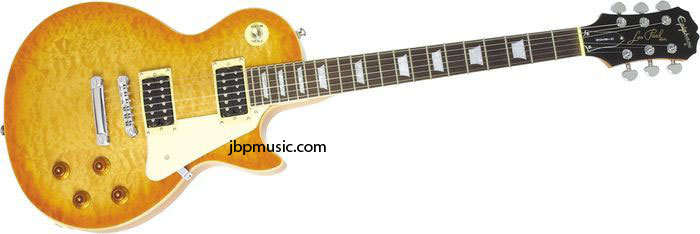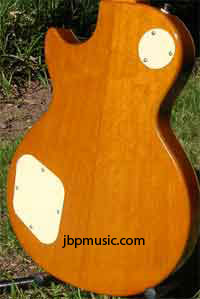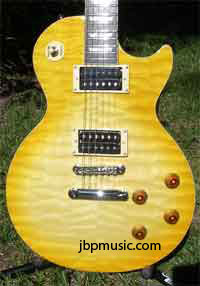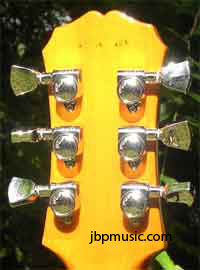Ibanez SZ520QM SZ520 Electric Guitar Review
Ibanez SZ520QM Electric Guitar ReviewWhen I was first looking for an electric guitar that I could use as a recording guitar and as a way for my son to cut his guitar-chops, I searched high and wide. I had a severely limited budget at the time I began playing again… and had to get some of the features I knew that I liked in a guitar from my early days.
I wanted a guitar that was tough enough to handle hard rock guitar but that didn't fold on me over time. I also wanted an instrument with lots of sustain, plenty of output, and a nice neck.
I ended up settling on an Ibanez SZ520 for a number of reasons. For sure, though, the SZ520 is a remarkable instrument – one that is not given its true kudos in the world of guitars. It is an unsung hero and an excellent instrument.
Quick Opinion: The Ibanez SZ line of electric guitars (and, to an extent, the Ibanez S line of guitars) are excellent instruments. They have the quick feel of a rocker’s guitar, fairly good quality, and excellent features.
These guitars have excellent playability, great sound, and a price that puts them at the mid range between less-expensive set-necks, and inexpensive top-brands. SZs are not a bargain – rather, they are at the top of their range. Whether or not to purchase an SZ will depend very highly on your personal feature interests, and your particular desire for a given sound. Let’s take a look at this fine instrument – with some comparisons along the way.
The SZ is no longer produced as a new product by Ibanez, but you can see more about Free Shipping on Ibanez electrics at GuitarCenter.com
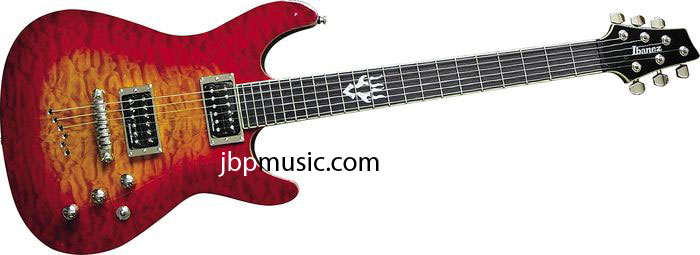
Ibanez SZ520QM Electric Guitar Review
Playability: Several things strike you immediately when you first pick up and play the SZ520. The neck is a dream – and lacks a big heel. The staggered, string-through design rings with sustain. The body is very nicely balanced and is of medium weight. The fretboard is comfortable.
The neck on the SZ520 is nearly ideal for chord players, shredders, and slide playing. It strikes a nice, medium-width balance against just a deep-enough “C” shape to get a grip on it when you’re running up and down the neck. The neck back is painted to match the body, and has a nice, hard, smooth finish. The neck-to-body join is superb on this instrument – few electrics get anywhere close to this nice of a join. The heel-less feels fantastic when you’re flitting around above the 14th fret. I truly wish most Gibsons and Epis had this type of neck join on their electric guitars.
The body balance is above average, if not pretty close to excellent. After playing the SZ for several hours, you don’t feel like you’re struggling with an unruly animal. It just feels good where it is – especially since the weight is medium in the spectrum. A Fender Stratocaster is significantly lighter in feel, and a Les Paul is a bit heavier in feel.
The fretboard, string-spacing, and fret size are an interesting combination – almost unique when compared to the other manufacturer’s view on fretboards. The fretboard is subtly different from most any other instrument out there. For those who are familiar with Fenders: it is thinner than a Strat and wider than a Tele – very similar to the superb and underrated Fender TC-90. For you Gibson and Epi fans out there, the SZ is much more like an Epiphone SG with respect to its neck. The fretboard is extremely similar to the Epi G400s I’ve played.
Fingerstyle players or players who use a modified pick hand (like myself) will find the strings a bit close together. However, this is balanced out by overall comfort, and the ease of gripping chords.
In order to get great sounds out of the SZ in slide and chord/soloing, the strings had to be at least 10s with thicker middle strings (and better, 11s or 12s). Custom light and extra-light strings sound muddy and don’t tune well when applied to the SZ. Also, the tone and sustain are robbed with smaller-gauge strings. I tried 10s Fenders, several 10s GHSs, and even the venerable D’Addario XL110s on the SZ, and none of them sounded very good. I ended up settling between D’Addario XLs with a minimum 11 high E-string and Ernie Ball Power Slinky (11.14.18.28.38.48). The Ernie Ball Power Slinky strings sounded the best by far.
If you’re not going to slide on the SZ, you’ll still need to get some good calluses and stay with a set that is 11 and above. 12s were just too thick for me on this instrument – I had a hard time getting a good vibrato and smooth-transition string-bends with 12s.
The fretwork of the SZ I owned was superb in almost any respect. The frets are medium in overall size and height, and the ends were reasonably well-dressed. The nut was well-worked and had no issues at all.
Features: The Ibanez SZ520QM (QM stands for “quilted maple” cap) is a high-feature guitar made in Korea. It has a gorgeous quilted maple cap on a warm and medium-thick mahogany body. The tuners are OK (not great), but the neck inlay is beautiful (my guitar got the name “blue flame” because of its 12th fret inlay). The finish on the guitar is deep and lustrous.
The heel-less neck feature is worth mentioning again. Feel it for yourself – most folks will absolutely love it.
The binding is light-cream, and is superbly done. I only felt the “edge” of the binding in one or two places on the front of the body, and none on the neck.
The Duncan/Ibanez open-face humbuckers are a nice feature. They strike a nice balance between being able to play stronger, more assertive music – and music that is marginally mellower.
The string-end design is string through. The staggered string holes are of varied lengths from the bridge and its saddles. Unlike many string-throughs, there is no tailpiece – the strings feed directly from the bridge to the holes in the body.
The Gibralter III bridge makes intonation a fairly easy task, and is completely buzz-free. It is stud-mounted to the top of the guitar, so lots of sound emanates through the bridge very nicely into the guitar body.
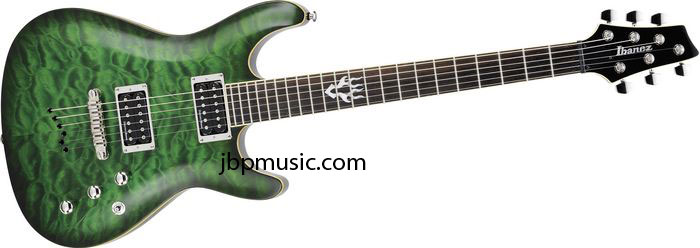
Sound: The SZ520QM sounds wonderful. It has tons of sustain (although an Epi or Gibson Les Paul still have a longer and warmer sustain – the SZ is more like a set-neck SG in sound and sustain). The pickups and electronics are clean and noise-free. Sonically, the SZ is a good crossover guitar – from harder music to classic rock.
I found the pickups to be not as high on the output scale (sound-wise – I didn’t pull them and put them on a multi-meter) as you get with EMGs or more aggressive Seymour Duncan humbuckers. They are louder than my first Epiphone Les Paul’s original open-face humbuckers, but they are not as rich and creamy.
The pickup-selection-and-tone part of the guitar is pretty good. The SZ has the often-used Tone-Volume-Volume plus pickup switch hardware setup. With the SZ520QM, there is one master tone knob, the middle knob controls the bridge pickup volume, and the knob closest to the neck controls the volume of the neck pickup. The SZ also uses a fairly standard (but extremely well-made) pickup selector toggle switch.
Value: Value for the money is where the SZ is not quite a clear winner. I don’t think the guitar is terribly over-priced, but it is not a bargain in any sense. The Fender TC-90 (albeit with Black Dove P90 pickups) and the Epiphone Explorer and Epiphone Flying V are much better performers – yet they all cost less. A similarly-equipped Dean, Jackson, or Schecter is generally a better bargain for sound and price.
With that said, and in all fairness, the SZ520 does have a great feel, and does a decent enough job for the sound. I am a fan of Ibanez guitars, and there are many models that are great… I just think the SZ 520 should be a little lower in price. – or should have higher-end Seymour Duncans to bring up the value.
Wishes: Some nickel-covered and upgraded Seymour Duncans would be great (or, even better, some EMG HZ passive pickups, perhaps H4s). I really think Ibanez should choose to use some nice Grovers as tuners, or at least some locking tuner/locking nut offerings on this guitar.
Labels: acoustic guitar, bear, electric guitar, ibanez, review, set neck, shredder, sz, sz520, sz520QM
